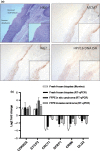Deregulation of SYCP2 predicts early stage human papillomavirus-positive oropharyngeal carcinoma: A prospective whole transcriptome analysis
- PMID: 26334652
- PMCID: PMC4714680
- DOI: 10.1111/cas.12809
Deregulation of SYCP2 predicts early stage human papillomavirus-positive oropharyngeal carcinoma: A prospective whole transcriptome analysis
Abstract
This study was designed to identify significant differences in gene expression profiles of human papillomavirus (HPV)-positive and HPV-negative oropharyngeal squamous cell carcinomas (OPSCC) and to better understand the functional and biological effects of HPV infection in the premalignant pathway. Twenty-four consecutive patients with locally advanced primary OPSCC were included in a prospective clinical trial. Fresh tissue samples (tumor vs. matched normal epithelium) were subjected to whole transcriptome analysis and the results validated on the same cohort with RT-quantitative real-time PCR. In a separate retrospective cohort of 27 OPSCC patients, laser capture microdissection of formalin-fixed, paraffin-embedded tissue allowed RNA extraction from adjacent regions of normal epithelium, carcinoma in situ (premalignant) and invasive SCC tissue. The majority of patients showed evidence of high-risk HPV16 positivity (80.4%). Predictable fold changes of RNA expression in HPV-associated disease included multiple transcripts within the p53 oncogenic pathway (e.g. CDKN2A/CCND1). Other candidate transcripts found to have altered levels of expression in this study have not previously been established (SFRP1, CRCT1, DLG2, SYCP2, and CRNN). Of these, SYCP2 showed the most consistent fold change from baseline in premalignant tissue; aberrant expression of this protein may contribute to genetic instability during HPV-associated cancer development. If further corroborated, this data may contribute to the development of a non-invasive screening tool. This study is registered with the UK Clinical Research Network (ref.: 11945).
Keywords: Diagnosis by tumor markers and biomarkers; Rb/p16-related genes; human papillomavirus; mRNA expression analysis; oropharyngeal carcinoma.
© 2015 The Authors. Cancer Science published by Wiley Publishing Asia Pty Ltd on behalf of Japanese Cancer Association.
Figures





Similar articles
-
Human papillomavirus in oropharyngeal squamous cell carcinoma: assessing virus presence in normal tissue and activity in cervical metastasis.Laryngoscope. 2012 Dec;122(12):2707-11. doi: 10.1002/lary.23516. Epub 2012 Sep 7. Laryngoscope. 2012. PMID: 22961429
-
Identification of transcriptionally active HPV infection in formalin-fixed, paraffin-embedded biopsies of oropharyngeal carcinoma.Hum Pathol. 2015 May;46(5):681-9. doi: 10.1016/j.humpath.2014.12.014. Epub 2015 Jan 14. Hum Pathol. 2015. PMID: 25708613
-
P16(INK4A) immunostaining is a strong indicator for high-risk-HPV-associated oropharyngeal carcinomas and dysplasias, but is unreliable to predict low-risk-HPV-infection in head and neck papillomas and laryngeal dysplasias.Int J Cancer. 2014 May 1;134(9):2108-17. doi: 10.1002/ijc.28534. Epub 2013 Oct 21. Int J Cancer. 2014. PMID: 24127203
-
Human papillomavirus and oral and oropharyngeal carcinoma: the essentials.Aust Dent J. 2019 Mar;64(1):11-18. doi: 10.1111/adj.12652. Epub 2018 Oct 7. Aust Dent J. 2019. PMID: 30238467 Review.
-
From HPV-positive towards HPV-driven oropharyngeal squamous cell carcinomas.Cancer Treat Rev. 2016 Jan;42:24-9. doi: 10.1016/j.ctrv.2015.10.009. Epub 2015 Oct 31. Cancer Treat Rev. 2016. PMID: 26547133 Review.
Cited by
-
Meiotic protein SYCP2 confers resistance to DNA-damaging agents through R-loop-mediated DNA repair.Nat Commun. 2024 Feb 21;15(1):1568. doi: 10.1038/s41467-024-45693-2. Nat Commun. 2024. PMID: 38383600 Free PMC article.
-
Salivary exRNA biomarkers to detect gingivitis and monitor disease regression.J Clin Periodontol. 2018 Jul;45(7):806-817. doi: 10.1111/jcpe.12930. Epub 2018 Jun 15. J Clin Periodontol. 2018. PMID: 29779262 Free PMC article.
-
Structure and transcription of integrated HPV DNA in vulvar carcinomas.NPJ Genom Med. 2024 Jun 19;9(1):35. doi: 10.1038/s41525-024-00418-8. NPJ Genom Med. 2024. PMID: 38898085 Free PMC article.
-
Molecular analyses of unselected head and neck cancer cases demonstrates that human papillomavirus transcriptional activity is positively associated with survival and prognosis.BMC Cancer. 2016 Jun 13;16:367. doi: 10.1186/s12885-016-2398-7. BMC Cancer. 2016. PMID: 27296171 Free PMC article.
-
Role of DNA Methylation Profiles as Potential Biomarkers and Novel Therapeutic Targets in Head and Neck Cancer.Cancers (Basel). 2023 Sep 22;15(19):4685. doi: 10.3390/cancers15194685. Cancers (Basel). 2023. PMID: 37835379 Free PMC article. Review.
References
-
- Mehanna H, Beech T, Nicholson T et al The prevalence of human papillomavirus in oropharyngeal and nonoropharyngeal head and neck cancer: a systematic review and meta‐analysis of trends by time and region. Head Neck 2012; 35: 747–55. - PubMed
-
- Hoffmann M, Ihloff AS, Gorogh T, Weise JB, Fazel A, Krams M. p16(INK4a) overexpression predicts translational active human papillomavirus infection in tonsillar cancer. Int J Cancer 2010; 127: 1595–602. - PubMed
-
- Oliver M, Eeles R, Holstein M, Khan MA, Harris CC, Hainaut P. The IARC TP53 database: new online mutation analysis and recommendations to users. Hum Mutat 2002; 19: 607–14. - PubMed
Publication types
MeSH terms
Substances
Associated data
- Actions
Grants and funding
LinkOut - more resources
Full Text Sources
Other Literature Sources
Molecular Biology Databases
Research Materials
Miscellaneous

